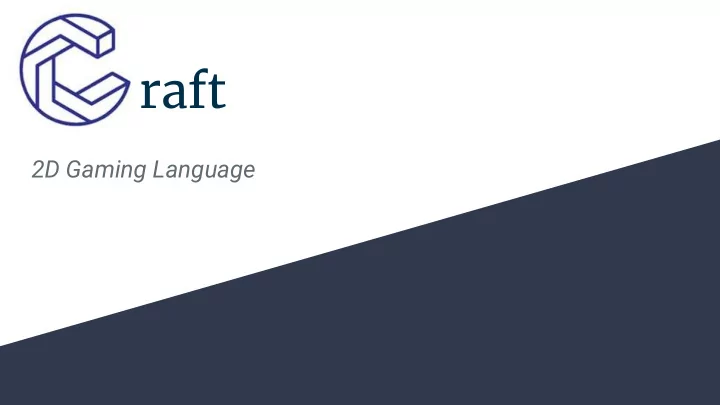

raft 2D Gaming Language
The Team Member Main Responsibility Martin Code Generation Fagerhus Roy Prigat Compiler Front End Abhijeet C - Implementation, SDL Mehrotra Daniel Tal Semantic Checking
Motivation and Why is it so difficult to create games in ● languages such as C or Java? Goals Worry about game loop ○ Difficulty in defining binding events to ○ specific elements. Tedious ○
Why Us? We allow a user to build a 2D game ● with ease of just worrying about adding user defined elements, events, and a world This is all done with much less code ● and makes it more straight forward for the programmer to develop a game We include in-built language ● components to make game building easy to do/understand
Program Structure <global variables> <global functions> Designed for ease of use and ● straightforward semantics. <event definitions> <Event> <condition> A world is the only required ● <action> component. <element definitions> If an element is defined, it is ● required to add its properties as <element> well(color,size). <properties> - required <world definition> - required <world> <properties> - required <local variables> <statements block>
Types Color and size are properties of ● int a = 3; world and element components. Color is a string literal which ● bool b = true; corresponds to hex codes. float f = 3.4; Size is a pair type which defines ● the pixel size of an element/world. string s = “hello”; pair p = (50,70);
Events Define game “rules” ● Condition defines the expression ● event move_down(player) { that triggers the event when true. condition = key_press(“DOWN”); Action defines how the event ● reacts with the element it binds to. action { Player1.pos.x = 400; } }
Elements Properties ● element player { Size of type Pair ○ size = (50,50); Color (a hex string) ○ color = “f44141”; Direction (Integer) - optional ○ Speed (Integer) - optional ○ direction = 90; speed = 1; }
World Properties - required ● world { Size of type Pair ○ properties { size = (500,200); Color (a hex string) ○ color = “42f4eb”; Adding new elements to the game } ● element player = new player(20,20); environment add_event(move_up); } Adding event to the event loop, ● where each event is bound to a selected element.
if (true){ Control Flow x = 5; If/else } else { x = 3; } int x = 0; while(x == 0){ While add_event(move_up); loops x = x +1; } int x = 0; for(x , x <= 10, x++){ For loops add_event(move_down); }
Sample Program A game with one player which can ● move up on pressing “UP” arrow key
Runtime Based on SDL ● Infinite loop ● Has functions to: ● Render elements ○ Help determine collisions ○ Trigger callback functions ○
Architecture
Testing Automated Tests Declarations ● An automated testing script runs over all ● test files and produces a testall.log. Statements ● The log file includes the output of all ● Functions ● tests. Expressions ● Fail tests output exceptions as defined in ● the semantics checker, these are printed Semantics ● out in the log file. Success tests simply produce an ● executable program which is later Manual Tests manually tested. Colors and size ● Elements ● Event actions ●
Demo
Recommend
More recommend